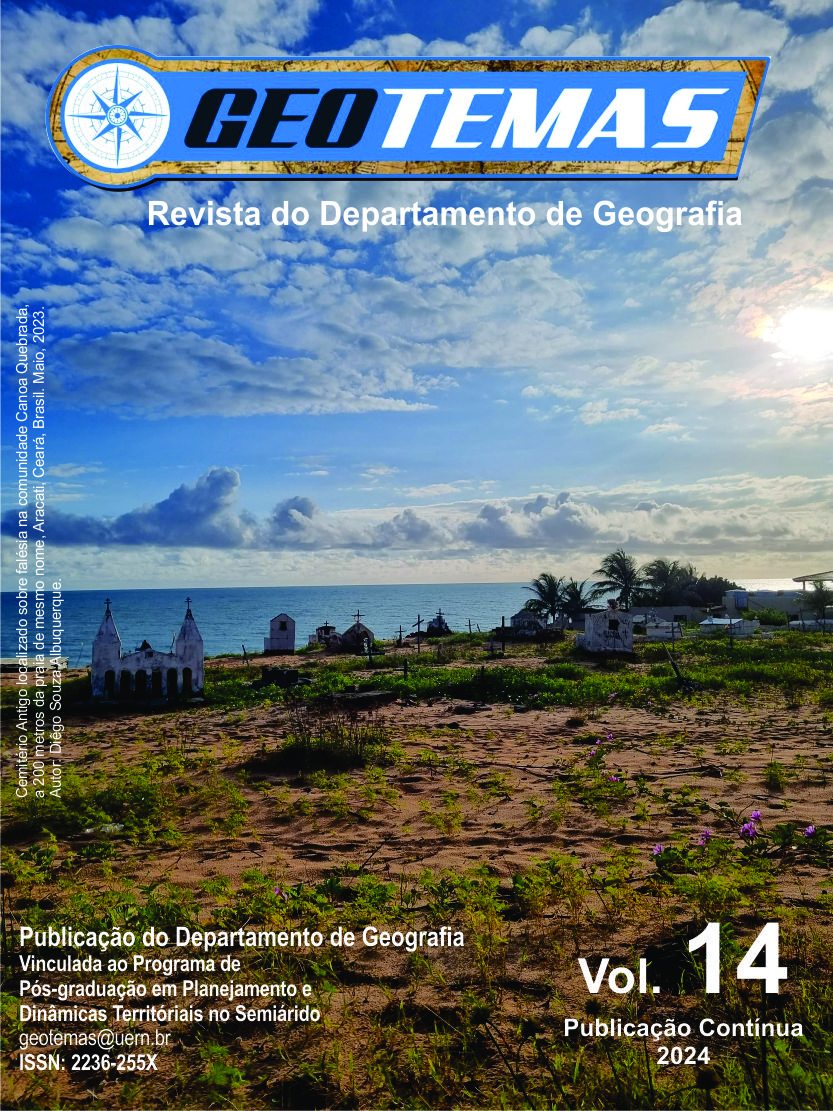A CONSOLIDAÇÃO DE ÁREAS URBANAS POLARIZADAS NO SEMIÁRIDO DO NORDESTE BRASILEIRO
DOI:
https://doi.org/10.33237/2236-255X.2024.5466Palavras-chave:
Polarização, Processo, Espaço capitalista, Dados textuais, IramuteqResumo
Este artigo entende que a polarização é um fenômeno que atua na produção desigual do espaço capitalista. O seu objetivo é identificar, na produção acadêmica (entre os anos 2000 e 2021), fatores que podem ser relacionados com a consolidação de áreas urbanas polarizadas no Semiárido do Nordeste do Brasil. A metodologia utilizada foi a execução de revisão bibliográfica sistemática integrativa. Os dados textuais foram analisados com o apoio do software Iramuteq. Os principais fatores identificados foram: o movimento de expansão capitalista; ações estatais de desenvolvimento regional e de atração de atividades industriais; a continua especialização produtiva das áreas urbanas e a consequente expansão do comércio e dos serviços.
Downloads
Referências
ALVES, L. R. Região, urbanização e polarização. In: PIACENTI, C. A.; LIMA, J. F.; EBERHARDT, P. H. C. Economia e desenvolvimento regional. Foz do Iguaçu: Parque Itaipú, 2016. p. 41-52. Disponível em: https://www5.unioeste.br/portalunioeste/arq/files/PGDRA/EconomiaeDesenvolvimentoRegional.pdf. Acesso em: 05 mar. 2022.
ALVES, A. M. Políticas de desenvolvimento regional e rede de cidades no Semiárido: concentração, polarização e fragmentação. 2017. 288 f., il. Tese (Doutorado em Geografia) - Universidade de Brasília, Brasília, 2017.
ANDRADE, M. C. Espaço, Polarização e desenvolvimento: a teoria dos polos de desenvolvimento e a realidade Nordestina. Recife: Centro Regional de Administração Municipal, 1967.
BOTELHO, L. L. R.; CUNHA, C. C. de A.; MACEDO, M. O método da revisão integrativa nos estudos organizacionais. Gestão e Sociedade, [S. l.], v. 5, n. 11, p. 121–136, 2011.
BRANDÃO, C. A. Território & desenvolvimento: as múltiplas escalas entre o local e o global. Campinas: Editora da UNICAMP, 2012.
BRENNER, N. Espaços da urbanização: o urbano a partir da teoria crítica. Rio de Janeiro, LetraCapital, 2018.
CANO, W. Desequilíbrios regionais e concentração industrial no Brasil. Campinas: Editora UNICAMP, 1998.
CLEMENTINO, M. L. M; PESSOA, Z. S. Estudos prospectivos sobre o Desenvolvimento do Nordeste: desenvolvimento urbano. Fortaleza. BNB. 2013. (Nota Técnica 166).
COUTO, E. M. J.; ELIAS, D. Evolução do comércio e dos serviços em uma cidade média no Brasil. Revista GeoUECE, [S. l.], v. 4, n. 7, p. 09–35, 2021. Disponível em: https://revistas.uece.br/index.php/GeoUECE/article/view/6922. Acesso em: 9 mar. 2022.
CORAGGIO, J. L. Hacia una revisión de la teoría de los polos de desarrollo. Versão revisada do artigo de mesmo titulo publicado em: EURE, II, num. 4, 1972.
CUNHA, E.; SOUZA, W. Administração e indígenas no Brasil: conhecimento e interesse na pesquisa stricto sensu. Cad. EBAPE.BR, v. 20, n. 1, Rio de Janeiro, Jan./Fev. 2022
FURIÓ, E. Evolución y cambio en la economía regional. Barcelona: Editorial Ariel, 1996.
FRIEDMANN, J. Regional economic policy for developing areas. Papers In Regional Science, [S.L.], v. 11, n. 1, p. 41-61, jan. 1963. Wiley. http://dx.doi.org/10.1111/j.1435-5597.1963.tb01889.x.
GALVÃO M. C. B.; RICARTE, I. L. M. Revisão Sistemática da Literatura: Conceituação, Produção e Publicação. LOGEION: Filosofia da informação, Rio de Janeiro, v. 6 n. 1, p.57-73, set.2019/fev. 2020.
HAGGETT, P. L’analyse spatiale en géographie humaine. Paris: Armand Colin, 1973.
HARVEY, D. Condição pós-moderna. São Paulo: Edições Loyola, 1992
HARVEY, D. A produção capitalista do espaço, São Paulo: Annablume, 2005.
HARVEY, D. Os limites do capital, São Paulo: Boitempo, 2013.
INSTITUTO BRASILEIRO DE GEOGRAFIA E ESTATÍSTICA – IBGE. Regiões de Influência de Cidades. Rio de Janeiro: IBGE, 2008.
INSTITUTO BRASILEIRO DE GEOGRAFIA E ESTATÍSTICA – IBGE. Regiões de influência das cidades. Rio de Janeiro: IBGE, 2020.
INSTITUTO BRASILEIRO DE GEOGRAFIA E ESTATÍSTICA – IBGE. Produto Interno Bruto - PIB. 2021. Disponível em: https://www.ibge.gov.br/explica/pib.php. Acesso em: 10 nov. 2021.
INSTITUTO BRASILEIRO DE GEOGRAFIA E ESTATÍSTICA - IBGE. Semiárido Brasileiro. 2022. Disponível em: https://www.ibge.gov.br/geociencias/cartas-e-mapas/mapas-regionais/15974-semiarido-brasileiro.html?=&t=o-que-e. Acesso em: 05 jul. 2022.
JESSOP, B. Spatial Fixes, Temporal Fixes and Spatio-Temporal Fixes. Blackwell Publishing, 2006.
JESSOP, B. BRENNER, N. JONES, M. Teorizando as relações socioespaciais. Geographia, [S.L.], v. 19, n. 41, p. 107-119, 25 jan. 2018. Pro Reitoria de Pesquisa, Pos Graduação e Inovação - UFF. Disponível em: https://periodicos.uff.br/geographia/article/view/13814. Acesso em: 08 fev. 2021.
MILANEZ, B.; SANTOS, R. S. P. Neodesenvolvimentismo e neoextrativismo: duas faces da mesma moeda. Encontro Anual da ANPOCS, v. 37, p. 1-30, 2013.
MONTEIRO NETO, A.; SILVA, R. O; SEVERIAN, D. O Território das atividades industriais no Brasil: a força das economias de aglomeração e urbanização. 2021. In: A. MONTEIRO NETO. (Orgs.) Brasil, Brasis: reconfigurações territoriais da indústria no século XXI. Brasília: IPEA, 2021. P. 255-314.
PERROUX, F. O conceito de pólos de crescimento. In: J. SCWARTZMANN (Org.) Economia regional e urbana: textos escolhidos. Belo Horizonte: UFMG, 1977.
PEREIRA JÚNIOR, E. Industrial dynamics and urbanization in the Northeast of Brazil. Mercator, [S.L.], v. 14, n. 4, p. 63-81, 23 dez. 2015. http://dx.doi.org/10.4215/rm2015.1404.0005. Disponível em: https://www.scielo.br/j/mercator/a/yKwDGNYkGK56bKgFn78yzJz/?format=pdf&lang=pt Acesso em: 12 ago. 2021.
SANTOS, M. Técnica, espaço, tempo. São Paulo: Hucitec, 1994.
SANTOS, M. Economia Espacial: Criticas e Alternativas. São Paulo: EDUSP, 2003.
SANTOS, M. Por uma economia política da cidade: o caso de São Paulo. São Paulo: EDUSP, 2009.
SALVIATI, M. E. Manual do Aplicativo Iramuteq: versão 0.7 Alpha 2 e R Versão 3.2.3. 2017. Disponível em: http://www.iramuteq.org/documentation/fichiers/manual-do-aplicativo-iramuteq-par-maria-elisabeth-salviati Acesso em: 05 abr. 2022.
Downloads
Publicado
Como Citar
Edição
Seção
Licença
Copyright (c) 2024 Revista Geotemas

Este trabalho está licenciado sob uma licença Creative Commons Attribution 4.0 International License.
Os autores que submeterem seus manuscritos para a Geotemas declaram que o trabalho trata-se de artigo original, não tendo sido submetido para publicação, na íntegra ou em parte, em outro periódico científico nacional ou internacional ou em outro veículo de circulação. Os autores declaram também que concordam com a transferência dos direitos autorais do referido artigo para a revista Geotemas (Universidade do Estado do Rio Grande do Norte), permitindo publicações posteriores, desde que seja assegurada a fonte de sua publicação. Assumem, por fim, a responsabilidade pública pelo artigo, estando cientes de que poderão incidir sobre os mesmos os eventuais encargos decorrentes de reivindicação, por parte de terceiros, em relação à autoria do trabalho.
























